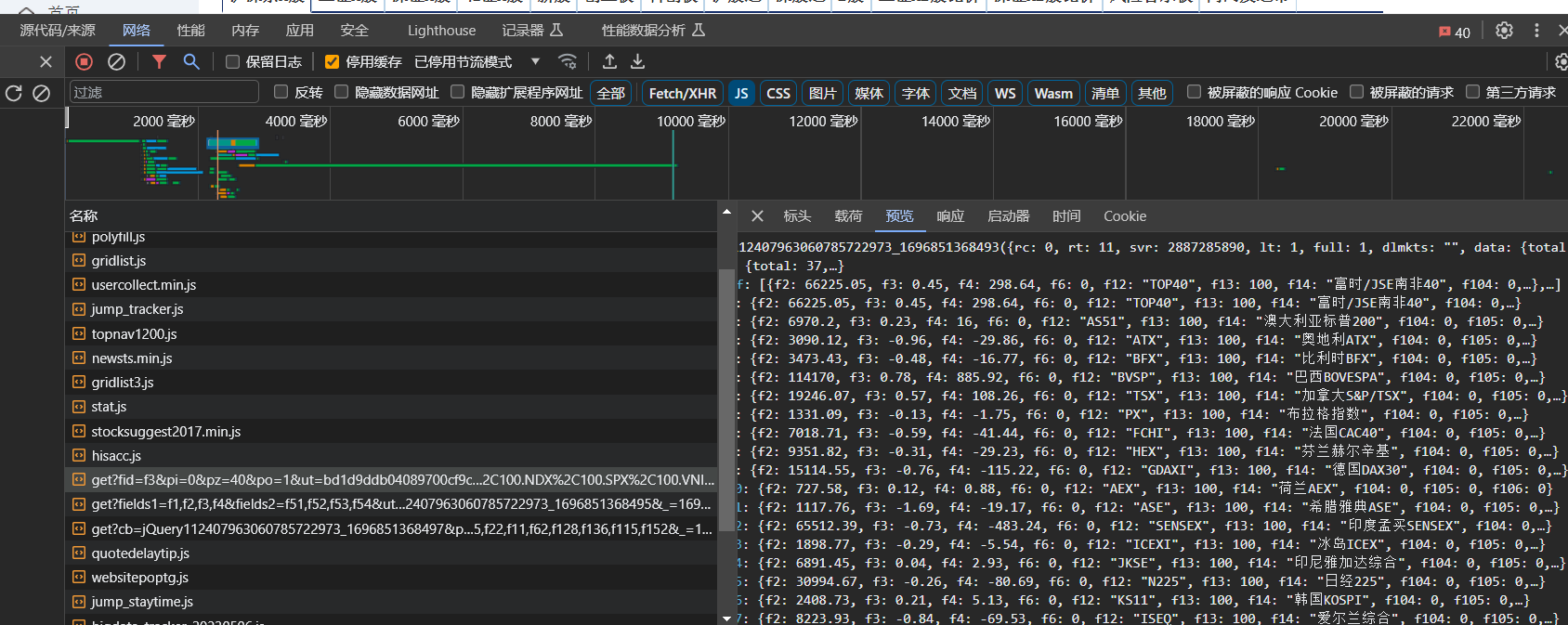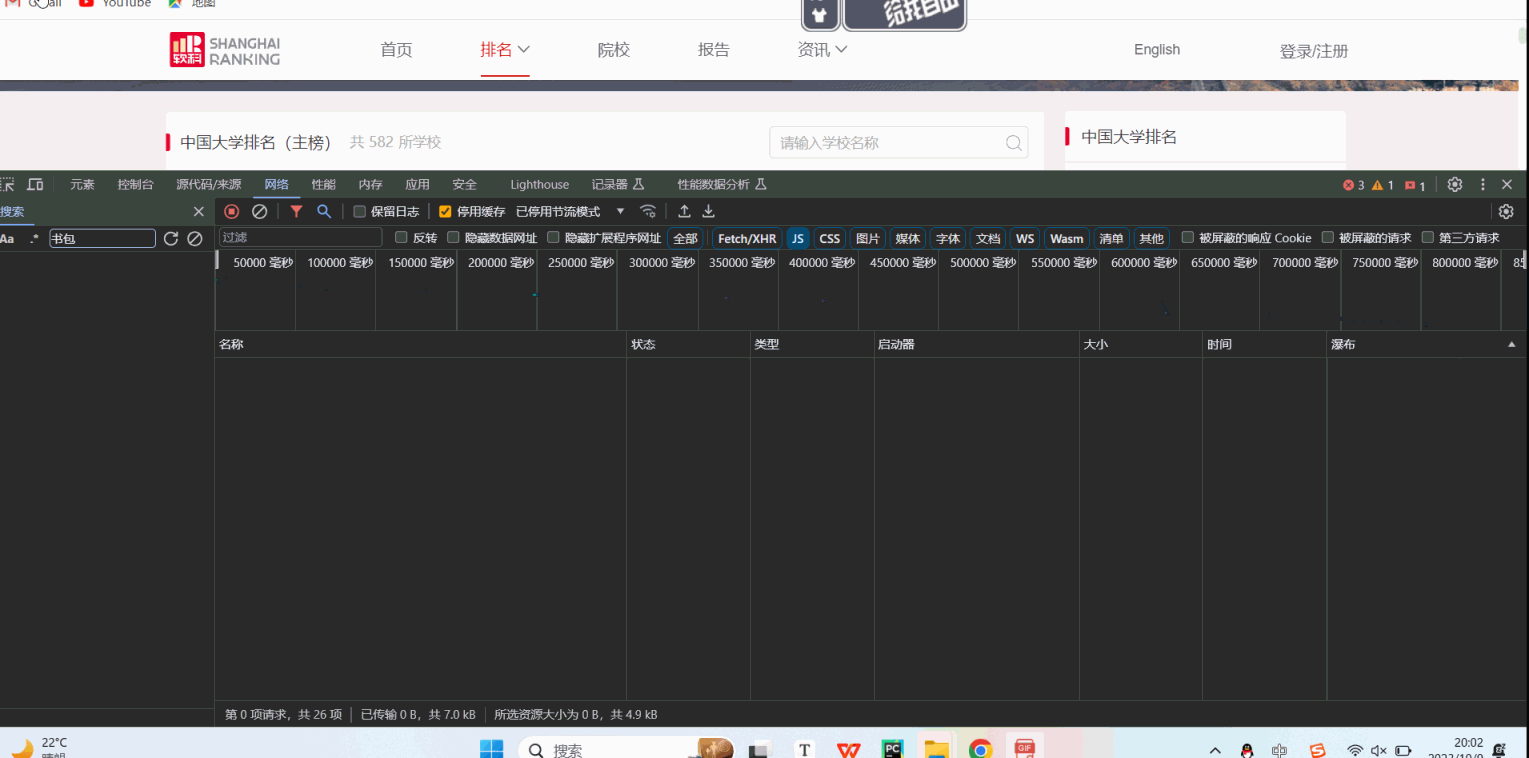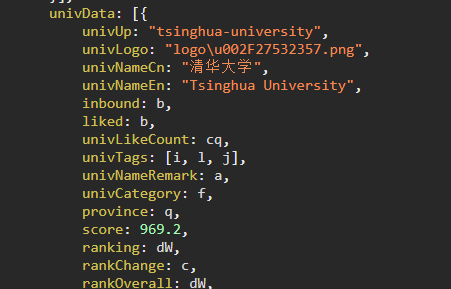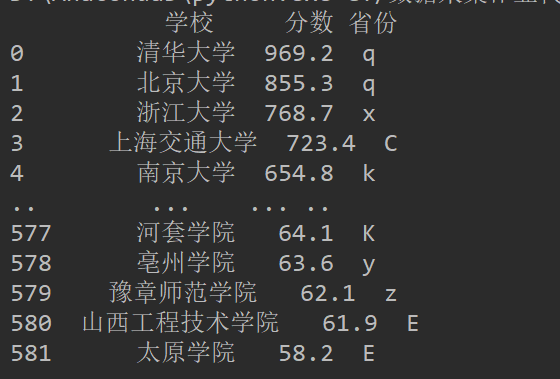2023数据采集与融合实践第二次作业
第二次作业
码云连接:https://gitee.com/crazypsz/spider/commit/566b31106cde3cd68bd87c63e851b299542e6565
作业一
实验
要求:在中国气象网(http://www.weather.com.cn)给定城市集的 7
日天气预报,并保存在数据库。
思路解析:
- 预设需要存储的数据在数据库中的形式
| 序号 | 地区 | 日期 | 天气信息 | 温度 |
|---|
- 创建存储数据的的专属类 weatherDB
该类包含以下主要方法:
-
openDB(): 创建数据库,初始化数据库连接connect和游标cursor
-
closeDB(): 关闭数据库
-
insert(): 传入参数为5个数据,并将一行数据插入
-
show():展示数据库的内容,输出到控制台
class WeatherDB: def __init__(self): super() def openDB(self): self.con=sqlite3.connect("G:\database\weathers.db") self.cursor=self.con.cursor() try: self.cursor.execute("create table if not exists weathers (id varchar(16),wCity varchar(16),wDate varchar(16),wWeather varchar(64),wTemp varchar(32),constraint pk_weather primary key (id))") except: self.cursor.execute("delete from weathers") def closeDB(self): self.con.commit() self.con.close() def insert(self, count,city, date, weather, temp): try: self.cursor.execute("insert into weathers (id,wCity,wDate,wWeather,wTemp) values (?,?,?,?,?)", (count,city, date, weather, temp)) except Exception as err: print(err) def show(self): self.cursor.execute("select * from weathers") rows = self.cursor.fetchall() print("%-16s%-16s%-16s%-32s%-16s" % ("id","city", "date", "weather", "temp")) # print(“{0:{4}^16}{1:{4}^16}{2:{4}^32}{3:{4}^32}”.format(“city”,“date”,\ # “weather”,“temp”,chr(12288))) for row in rows: print("%-16s%-16s%-16s%-32s%-16s" % (row[0], row[1], row[2], row[3],row[4]))
-
编写一个爬取天气网站的类
- 初始化: 请求头,城市与城市代码之间的映射
- forecastcity():根据页面源码,解析页面数据
- process():接受需要爬取的城市参数,启动forecasticity()分别爬取每个城市的天气信息
class WeatherForecast: def __init__(self): self.headers = { "User-Agent": "Mozilla/5.0 (Windows; U; Windows NT 6.0 x64; en-US; rv:1.9pre) Gecko/2008072421 Minefield/3.0.2pre"} self.cityCode = {"北京": "101010100", "上海": "101020100", "广州": "101280101", "深圳": "101280601"} self.count=0 def forecastCity(self, city): if city not in self.cityCode.keys(): print(city + " code cannot be found") return url = "http://www.weather.com.cn/weather/" + self.cityCode[city] + ".shtml" try: req = urllib.request.Request(url, headers=self.headers) data = urllib.request.urlopen(req) data = data.read() dammit = UnicodeDammit(data, ["utf-8", "gbk"]) data = dammit.unicode_markup soup = BeautifulSoup(data, "lxml") lis = soup.select("ul[class='t clearfix'] li") for li in lis: try: date = li.select('h1')[0].text weather = li.select('p[class="wea"]')[0].text temp = li.select("p[class='tem']")[0].text.strip() # print(city,date,weather,temp) self.db.insert(self.count,city, date, weather, temp) self.count=self.count+1 except Exception as err: print(err) except Exception as err: print(err) def process(self, cities): self.db = WeatherDB() # 创建天气数据库对象,db self.db.openDB() # 打开数据库 for city in cities: self.forecastCity(city) # 循环遍历,逐一爬取和存储天气预报数据 # self.db.show()#打印数据库中数据 self.db.show() self.db.closeDB() # 关闭数据库 -
主程序
ws = WeatherForecast() # 创建天气预报类对象ws ws.process(["北京", "上海", "广州", "深圳"]) # 对指定的城市进行天气预报数据的爬取和存储 print("completed") -
运行结果
id city date weather temp
0 北京 9日(今天) 晴 10℃
1 北京 10日(明天) 晴 22℃/10℃
2 北京 11日(后天) 晴转多云 23℃/10℃
3 北京 12日(周四) 多云转小雨 21℃/12℃
4 北京 13日(周五) 晴 22℃/10℃
..................................................................................
心得
这个实验的页面的解析的难度不是很大,这次实验比较不一样的是要将数据存入数据库中,刚好可以熟悉一下数据库的操作,然后其实这个代码知识一个demo而已,如果没有做好城市和城市代码的映射,那么这个城市的的数据就爬不到了,如果感兴趣,可以做一个全国城市的映射,然后根据这个爬虫开发一个小程序
作业2
实验
要求:用 requests 和 BeautifulSoup 库方法定向爬取股票相关信息,并
存储在数据库中。
候选网站:东方财富网:https://www.eastmoney.com/
新浪股票:http://finance.sina.com.cn/stock/
思路解析:
- 打开东方财富网的网站,按F12,点击网络,刷新页面,观察服务器返回的各项数据,可以观察到需要的数据是在一个js的文件中

-
根据上面文件的url, 解析这个js文件将其有效数据转化成Pythond的数据类型,可以发现每一条数据都是一个字典,但是其key值需要自己根据value, 做好其名称的映射,单页数据爬取的函数如下
def get_one_pagesource(page_num=1): base_url =r'http://36.push2.eastmoney.com/api/qt/clist/get?cb=jQuery1124017913335698798893_1696658430311&pn={}&pz=20&po=1&np=1&ut=bd1d9ddb04089700cf9c27f6f7426281&fltt=2&invt=2&wbp2u=|0|0|0|web&fid=f3&fs=m:0+t:6,m:0+t:80,m:1+t:2,m:1+t:23,m:0+t:81+s:2048&fields=f1,f2,f3,f4,f5,f6,f7,f8,f9,f10,f12,f13,f14,f15,f16,f17,f18,f20,f21,f23,f24,f25,f22,f11,f62,f128,f136,f115,f152&_=1696658430312' url = base_url.format(page_num) headers= { 'User-Agent': 'Mozilla/5.0 (Windows NT 10.0; Win64; x64) AppleWebKit/537.36 (KHTML, like Gecko) Chrome/117.0.0.0 Safari/537.36' } response = requests.get(url,headers=headers) content = response.content # print(content) temp_file= content temp_file= str(temp_file.decode('utf-8')) temp_file= temp_file.split('(',maxsplit=1)[1] temp_file = temp_file[:-2] # print(a) json_file = json.loads(temp_file) # print(json_file) data_list= json_file['data']['diff'] for data in data_list: dic['名称'].append(data['f14']) dic['最新价格'].append(data['f2']) dic['涨跌幅'].append(str(data['f3'])+"%") dic['涨跌额'].append(data['f4']) dic['成交量'].append(data['f5']/1000.0) dic['成交额'].append(data['f6']/100000000.0) dic['振幅'].append(str(data['f7'])+"%") dic['最高'].append(data['f15']) dic['最低'].append(data['f16']) dic['今开'].append(data['f17']) dic['昨收'].append(data['f18']) dic['量比'].append(data['f10']) dic['代码'].append(data['f12']) -
多页数据爬取,上面的页面的url只有pn这个参数是在变化,因此只需要修改pn值,就可以访问其他网页, 由于属性太多了,就直接保存在本地的xlsx文件当中
if __name__ =="__main__": num =3 df = pandas.DataFrame() dic = {"代码":[], "名称":[],"最新价格":[], "涨跌额":[], "涨跌幅":[],"成交量":[], "成交额":[], "振幅":[], "最高":[], "最低":[], "今开":[], "昨收":[], "量比":[]} for page_num in range(1,num+1): get_one_pagesource(page_num) for name in dic.keys(): df[name]=dic[name] df.to_excel('./沪深京A股.xlsx') print('爬取结束') -
运行结果,生成的本地文件

心得体会
这题难点在于网络抓包吧,不仔细观察的话,就看不到数据的的接口,真正去做的话,应该大部分时间是在找借口,和做反爬,越到后面,页面解析的部分就是最简单的了
作业3
实验
要求:爬取中国大学 2021 主榜
(https://www.shanghairanking.cn/rankings/bcur/2021)所有院校信息,并存储在数据库中,同时将浏览器 F12 调试分析的过程录制 Gif 加入至博客中。
技巧:分析该网站的发包情况,分析获取数据的 api
思路解析
- 进入网站打开f12 ,点击网络,刷新,抓取数据接口,可知数据在payload.js中

-
观察文件中单项数据的源码

-
可以直接使用正则去匹配每项数据
import requests import re import pandas url=r'https://www.shanghairanking.cn/_nuxt/static/1695811954/rankings/bcur/2021/payload.js' # url = r'https://www.shanghairanking.cn/_nuxt/static/1695811954/payload.js' headers={ 'User-Agent': 'Mozilla/5.0 (Windows NT 10.0; Win64; x64) AppleWebKit/537.36 (KHTML, like Gecko) Chrome/117.0.0.0 Safari/' } response = requests.get(url,headers=headers) response.encoding='utf-8' content = response.text u_name = re.findall(r'univNameCn:"(.*?)"',content) u_score = re.findall(r'score:(.*?),', content) u_province = re.findall(r'province:(.*?),', content) df = pandas.DataFrame() df['学校']= u_name df['分数']=u_score df['省份']=u_province print(df) -
运行结果

-
另外一个思路,将获取的js文件之后获取使用 js2py 执行之后可以获取python 的数据类型,就不用使用正则去解析了
import requests import js2py from io import StringIO from contextlib import redirect_stdout url = r'https://www.shanghairanking.cn/_nuxt/static/1695811954/rankings/bcur/2021/payload.js' r = requests.get(url, timeout=20) if r.status_code == 200: r.encoding = 'utf-8' html = r.text js_function =html[len('__NUXT_JSONP__("/rankings/bcur/2021", ('):-3] # js2py.eval_js(js_function) #这个方法会报错、 js_code= f"console.log({js_function})" js= js2py.EvalJs() pyf = js2py.translate_js(js_code) #js 转换成 python f = StringIO() #io 流 with redirect_stdout(f): exec(pyf) #底层实现 s = f.getvalue() print(s)
心得
刚开做的时候很纠结用哪一种解析方法,一开始觉得直接使用 beautifulsoup的find是最快的,当我使用beautifulsoup解析出来之后,用尝试编写正则去解析,发现正则的方式更简单,其实原因还是在于自己对于正则表达式还不够熟悉吧,所以不能一下子就反应过来去使用正则的方式,然后第二种思路,其实一开始没想过要把里面的数据转换出来,经过老师的提醒而去尝试的


 浙公网安备 33010602011771号
浙公网安备 33010602011771号